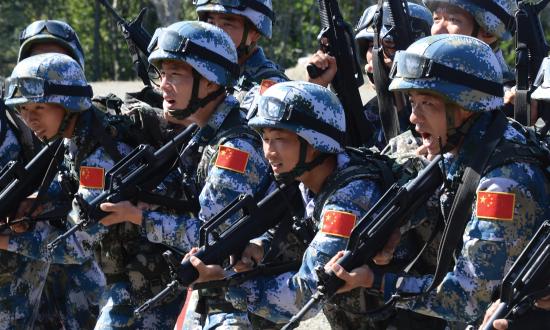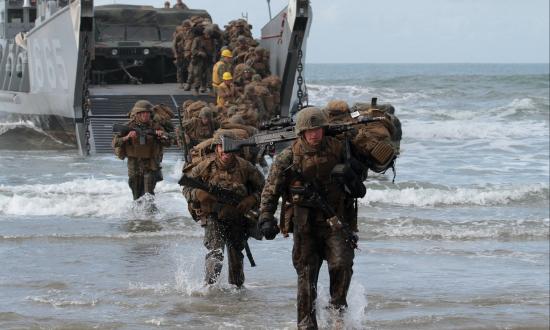The Marine Corps has retired its entire tank force and will rely on the Army for heavy armored support. The People’s Liberation Army Navy Marine Corps (PLANMC) has taken the opposite approach. Aside from fielding its own main battle tanks, the PLANMC also uses amphibious tanks alongside a litany of other armored fighting vehicles. If the U.S. Marine Corps had to fight China tomorrow, its ground forces would be woefully outmatched in firepower and armored protection.
The most capable Marine ground vehicles remaining are the Light Armored Vehicles (LAVs) family used to equip light armored reconnaissance (LAR) battalions. In Marine Corps doctrine, these units are not for offensive use: LAR battalions are tasked with reconnaissance and security operations, with only limited offensive and defensive capabilities. These vehicles are almost 40 years old, and a replacement is overdue as the LAVs are plagued with maintenance problems. Some stem simply from old age, while others from the countless upgrades added but never included in the original design.
The LAVs’ service history shows its ineffectiveness against a mechanized force. During the First Persian Gulf War, Delta Company, 3d Light Armored Infantry (LAI) Battalion was tasked with screening north along the Saudi-Kuwaiti border. The border was fortified with a dirt berm impassable to armored vehicles. On 29 January 1991, an Iraqi brigade equipped with Soviet T-62 main battle tanks and BMP infantry fighting vehicles ran headlong into the Marines. During the ensuing battle, two T-62s made it through a gap in the berm. The crews of the LAV-25s engaging them watched as their tungsten armor-piercing munitions ricocheted skyward off the tanks’ armor. The only vehicle capable of destroying heavy armor was the LAV-AT, an antitank version equipped with TOW ATGMs (antitank guided missiles). While the Marines were able to inflict some losses, ultimately it was close-air support that forced an Iraqi retreat.
Since that battle nearly 30 years ago, the LAV family of vehicles has not had any significant increase in their weapon systems’ capabilities. While the LAV-25 has been upgraded with thermal sights, it still has no way of defeating tanks. The LAV-AT has been equipped with a new turret, but the TOW missile system has significant drawbacks inherent to its design. LAV-ATs cannot fire while moving. In addition, the TOW missile’s semiautomatic control line-of-sight guidance requires the firing vehicle to remain exposed to the enemy to guide the missile all the way to its target. At maximum range, this can take up to 20 seconds. The TOW missile is slower not only than direct-fire cannon projectiles, but also Russian and Chinese ATGMs. This leaves the missile vulnerable to interception by the modern hard-kill active-protection systems modern tanks field.
The Marine Corps’ other ground combat vehicle is the Assault Amphibious Vehicle (AAV). The AAV is even older than the LAV and experiences similar problems; history has shown it is no longer suitable for frontline combat. In April 2003, at the Battle of Nasiriyah, eight AAVs were destroyed when they joined the heavy fighting in the city. Aside from being enormous targets—each nearly 27 feet long and 11 feet tall—they have limited capabilities to engage armor. AAVs are equipped with a one-man turret armed with an M2 heavy machine gun and a Mk 19 automatic grenade launcher. Because the turret is unstabilized, it cannot fire with any degree of accuracy while moving. Furthermore, the AAVs’ weapons are ineffective against anything besides soft skins. The AAVs’ armor is incapable of protecting the vehicle against anything more potent than medium machine guns, leaving them vulnerable to handheld infantry antiarmor weapons, ATGMs, and tank cannons.
The Marine Corps fields combined antiarmor team (CAAT) platoons in infantry battalions, mounted on Humvees or newer Joint Light Tactical Vehicles (JLTVs). At present, CAAT platoons use the same TOW missile LAR units use but could replace their TOWs with the more modern Javelin ATGMs. Javelins are fire-and-forget weapons that can use top-down or direct-attack profiles, allowing antiarmor teams to engage armored vehicles and move out before the missile even hits its target. However, Javelin missiles have shortcomings as well. They have a maximum effective range of 2,500 meters, substantially shorter than the older TOWs. With a 3,750-meter range, TOWs are also shorter-legged than Russian and Chinese missiles.
In addition to the inadequacies of their ATGMs, supporting CAAT vehicles use the same M2s and Mk 19s as AAVs. Neither of these would put even a dent in a main battle tank’s armor, and their maximum effective ranges are far shorter than those of even the oldest Chinese tank currently in service. The M2 heavy machine gun’s range is 1,830 meters, nearly 700 less than the Javelin it is supposed to support. Like AAVs, CAAT vehicles lack stabilized turrets, preventing them from firing while moving.
China’s military, on the other hand, has invested heavily in tanks—in fact, it has the largest tank force in the world. While the plurality of its armored force consists of older vehicles, the PLA nevertheless fields a large number of cutting-edge tanks equivalent or potentially superior to their Western counterparts. The Type 99 has a large-caliber gun capable of firing ATGMs, an autoloader enabling the tank to reload while moving over rough terrain, and an independent sight for the tank commander. Even its oldest tank—the Type 59, based on the Soviet T-54—is still potent. Its 100-millimeter main gun can destroy any vehicle the U.S. Marine Corps has. Newer Type 59 variants have received many upgrades, including reactive armor, a larger main gun, and improved sights and fire-control systems.
The PLANMC also fields light amphibious tanks. These typically have a reduced logistical footprint, because they use less fuel and are less prone to mechanical breakdowns than main battle tanks. One such vehicle is the ZLT-05 amphibious assault gun. Its 105-millimeter main gun can also fire ATGMs. For an infantry fighting vehicle, the PLANMC operates the amphibious ZBD-05. It is armed with a 30-millimeter main gun and ATGMs, and it carries eight infantrymen. Based on the same hull as the ZLT-05, both are capable of swimming from ship to shore under their own power. The PLANMC also uses the Type 08 family of wheeled armored vehicles for a variety of tasks.
While the Marine Corps’ move to retire its tanks left a wide gap between the capabilities of its ground combat element and that of the PLANMC, they were not retired without good reason. The M1A1 imposed an enormous logistical burden on supporting units—simply getting an Abrams from ship to shore was a challenge. The Navy’s ship-to-shore connectors can carry only limited numbers of Abrams—two on a landing craft utility and only one on a landing craft, air cushion (LCAC)—and they cannot be pre-boated. During the 2013 U.S.-Korean Ssang Yong exercise, Marines even had to build a pier and use cranes to get their tanks ashore.
The Marine Corps’ new Amphibious Combat Vehicle (ACV)—the AAV’s scheduled replacement—is being tested with a 30-millimeter autocannon, based on the Army’s new Dragoon variant of the Stryker fighting vehicle. While this new weapon system would give the ACV much-needed improvement in firepower compared with the AAV, it lacks any antitank capability. Some Strykers have been upgraded to incorporate the Javelin antitank missile, which might also work with the ACV. Despite the Javelin’s shortcomings, equipping Marine vehicles with it would give them the capability of engaging armored threats until a more capable system can be fielded.
Even with 30-millimeter-armed ACVs, the Marines will still lack a vehicle armed with a large-caliber direct-fire gun. However, there are many platforms similar to the ACV in active service that are armed with just such weapons. The Army’s Stryker Mobile Gun System, Japanese Type 16 Maneuver Combat Vehicle, and Italian Centauro are all armed with a 105-millimeter main gun. They are all also lighter than the ACV.Fielding such a vehicle would significantly reduce the logistical requirements on Marine units when compared to the Abrams while retaining the capability of an armored direct fire asset. This can be used not only to engage enemy vehicles, but also provide fire support to the infantry.
From main battle tanks to air-defense vehicles, the PLANMC’s vehicles outmatch those of the U.S. Marine Corps in firepower and armor protection. To win a fight with China, the Marine Corps will need to adopt new vehicles or substantially upgrade its existing ones.





